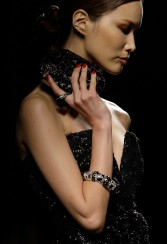S Korea luxury: beyond the obvious
 Louis Vuitton’s handbags have gone from a phenomenon in Korea to a bit of a joke. They are called the “three-second bags” or “five-second bags” because that’s how often you see one in the hands of fashion-conscious women (and their boyfriends who have to carry the handbag on a date).
Louis Vuitton’s handbags have gone from a phenomenon in Korea to a bit of a joke. They are called the “three-second bags” or “five-second bags” because that’s how often you see one in the hands of fashion-conscious women (and their boyfriends who have to carry the handbag on a date).McKinsey’s latest report on luxury goods concludes that there’s now an important shift in the fashion-savvy Korean market, which was worth $4.5bn last year.
People used to buy brands to show they were keeping up with trends and to show off that they had cash to flash. Now, McKinsey’s latest survey suggests people are buying brands to stick out from the crowd, not be part of the craze.
Koreans have tended to buy luxury goods as a way of signaling social status and for self indulgence. People wanted other people to know that they were wearing something expensive, so they bought famous brands, often with conspicuous logos or labels. That attitude is becoming passé with dizzying speed; in 2011, 45% of those surveyed agreed that “owning luxury goods is not as special as it used to be,” compared to just 21% in 2010. As a result, Koreans are beginning to think more about differentiation than display; 39% of heavy buyers and 26% of all respondents say that “I increasingly prefer luxury brands or items that help me stand out from the crowd.”This is certainly tangible even in supermarkets like Tesco and E-Mart, where there is a remarkable focus on supplying branded, individualistic clothing products, rather than the ultra-cheap basics you might expect from their equivalents in the West. Koreans shop online at eBay’s GMarket for basics and go to the stores for their bling.
Supermarkets aren’t cheap in Korea, but it’s the department stores where the de luxe action is. Department store sales were up 30 per cent in the first four months of 2011, compared with last year.
The big three – Hyundai, Lotte and Shinsegae (Samsung) – are planning major expansions outside Seoul. McKinsey suggests the department stores have got to prioritise the “heavy spenders” (who sound ominously rather like wives of executives at the big conglomerates (chaebol) and their kids).
For example, Lotte department store estimated that the number of “Most Valuable Customers”—those who spend 15 million won ($14,000) or more a year—rose 14.4% in 2010, compared to 9.2% for other kinds of luxury consumers. The number of VIP customers at Shinsegae department store —those who spend more than 8 million won ($7,400) —grew 35%, compared to 12% for other consumers.McKinsey notes there is also strong potential for men’s luxury goods, which still only account for 9 per cent of the luxury market – half of the level in Japan. The boom in men’s cosmetics certainly suggests there’s room in that market.
Young people are also rapidly turning into fashion victims.
Sales to 20-somethings rose at a stunning annual rate of 74% from 2005-10, compared to 9% for 50- to 60-year olds.What McKinsey shows is that Korea is still a good place for fashion houses – luxury sales have been up about 12 per cent each year since 2006 – but they must adapt to changing trends.
Intriguingly, several luxury goods makers note Korean culture is becoming so hip around Asia and beyond thanks to TV dramas and music, that they need a strong foothold in Seoul to identify trends that could spread from there.
But there’s also an unhappy dimension to luxury in Korea, as the gulf between rich and poor becomes increasingly severe.
Beyondbrics knows one middle-income family who will discuss driving long distances to save a few dollars on mackerel, but feel they also have to buy Paco Rabanne shirts because you have to present “face” in society.
Children are also damaged by the pursuit of luxury. Kids from chaebol families go to department stores armed with credit cards for fun after school. Poorer mums are reduced to tears when their children demand similar cards the family cannot afford. Most bizarrely, there has been almost a grotesque insistence among kids in Korea that the high-price is the most important thing. One son threw a tantrum when his father bought him some trendy jeans at a discounted store. The point of luxury was to pay the full price, the son explained to the bemused father.
Thankfully, McKinsey suggests progress is being made here and that Koreans are, at last, beginning to bargain hunt for luxury products.
While the McKinsey survey shows that Koreans (and heavy purchasers, in particular) are still more likely than the Japanese, Europeans or Americans to be willing to pay full price for luxury, at the same time, more and more are seeking out bargains.Some sanity there, at least.
Related reading:
Brazilian shoppers: no fear of recession, beyondbrics
Luxury on the Trans-Siberian express, beyondbrics
Chinese tourist fuel Hong Kong retail, beyondbrics
China’s women show taste for fast cars and whisky, FT
No comments:
Post a Comment